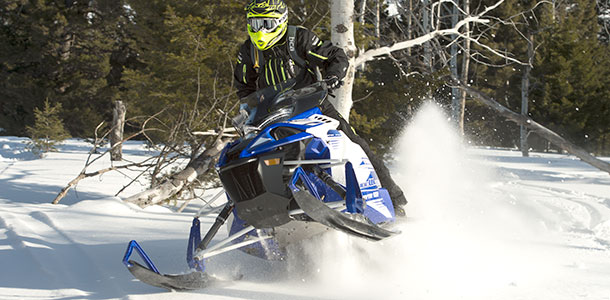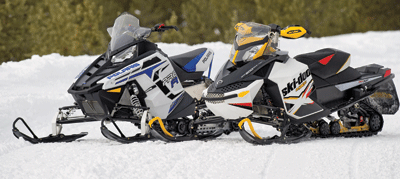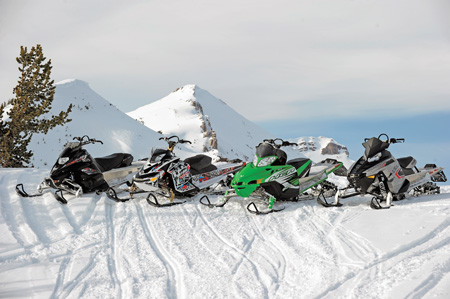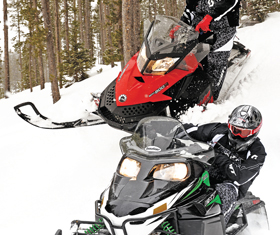As a class, the crossovers are tremendous sleds. They are the machines that dare to appeal to everyone. Want to ride briskly down the trail? No problem. Want to scout old logging roads? G’head. Leave on Sunday night on a weeklong saddlebag adventure before the groomers whack down the moguls? Sign here.
We tested the Arctic Cat Crossfire 6, Polaris 600 Dragon Switchback, Ski-Doo MX Z Renegade 600 H.O. E-TEC X and the Yamaha Nytro XTX. It’s easy to state the design goal for this foursome: Take the latest heart-of-the-market powerplant and wrap it into the best chassis, suspension and ergo arrangement they can weld, rivet, sew and bolt together for about every snow terrain and condition that exists.
As an engineering goal, it’s quite a feat. And just for the added challenge, the manufacturers thrust these four sleds into the hands of professional critics who don’t like compromises. We put them over trails rough and smooth and through untracked snow that was deep and full of obstacles.
And we were pleased. The sleds we gathered are the latest middleweight hybrids offered to the cash-or-credit public. They are all fabulous machines up to the ride-everywhere task. In many ways, the discriminating differences, comparisons and nuances were only discovered because of this head-to-head shootout.

ON THE TRAIL:
When we first started down the trail with these four sleds we realized little is compromised with longer tracks. Added length and all, they ride and handle as well — or better, in some cases — as their comparable short track siblings.
The Ski-Doo Renegade 600 H.O. E-TEC sports the most noteworthy engine of 2009. It’s the same technology we awarded with our 2009 Snowmobile of the Year with the Ski-Doo MX Z TNT 600 H.O. E-TEC. On the trail, the direct-injected Rotax is smooth, powerful crisp and clean. It lacks the thrilling punch of Polaris’ Liberty 600, though, but what it loses in grunt it more than makes up for in efficiency and cleanliness.
The lightweight REV-XP chassis is well grounded with the Renegade configuration and its 16-inch wide and 136-inch long track. Compared to a 120-inch REV-XP, the longer track is better at putting engine power to the ground and it steers more predictably with its longer wheelbase. One test driver stated that the Renegade navigated the corners best when driven hard into the corner. Braking later for the turn allowed more weight transfer for the skis, which helps the REV-XP carve a line. The skis pushed if riding at a slower pace or driving through the corner on the gas. But overall, the handling on the Renegade is remarkable.

The new rear suspension improved the 2009 Renegade by a healthy margin. On 2008 models there was harsh bottoming and occasional rebound kick from the front arm. But the new setup has eliminated harsh feedback and the system is more plush with a better, more progressive feel. The front end feels too light in some situations, though. In bumps, the front can wash and sway to the outside with the rebound stroke in small trail chatter, but it doesn’t lose its line. We mentioned already the remedy for corner push is weight transfer, which is something that can be easily changed with adjustments.
Of these machines, the Renegade’s ergos are the best for the trails, except for the X package looks-before-function windshield. The bars have a good angle and put the driver in a good position. When seated, the seat, console, tank and footwells are all conducive to letting the driver hang off the sled to exert influence on the lightweight chassis. The only comfort complaints about the cockpit are that the seat is too sticky for some drivers and the footwell stance is too wide.
With a dominating engine, great ergonomics, good suspension and predictable handling the Nytro XTX is Yamaha’s best-yet four-stroke sled. The engine in the Nytro XTX isn’t a fair comparison.
One of the most frequently stated advantages of four-stroke engines is a wider torque band. The Genesis 130 FI doesn’t just have an advantage; it exploits it. It has the most thrust of these sleds by quite a margin. And typical with Yamaha four-strokes, there is a pleasing sound to accompany the smooth, linear power.

The first-year FX Nytro models suffered from unwanted darting and unpredictable handling. The 2009 Nytro XTX was included in an update that improved handling, improve stability in bumps and improved overall rider comfort. The updates, including new A-arm geometry, a new spindle and a different sway bar, accomplished the goal. The changes make the sleds more predictable and stable than previous Nytro models; the XTX package is the best overall.
In hard, fast chatter bumps the front end gets a little squirrely and the larger the bump, the heavier the sled feels. The tipped rails certainly improve trail handling, but the front end still pushed in corners with loose snow. We think the corner push could be due to poor ski performance, because there is more than ample ski pressure. It’s common across the Nytro line — not exclusive to the XTX. The added length and weight of the longer rails and track help give the sled a better overall balance, though. It was most noticeable when decelerating; more grip from the rear kept the front tracking true.

There is more protection for the driver than looking at the machine would indicate. The bars, complete with hand guards, provide good control when powering through the corner. The seat is contoured well for aggressive driving and is plenty supportive and comfortable for high-mile days. The only nuisance in the ergonomics department is the toe holds at the top of the stirrups that puts a pressure point on the tops of feet.
Like other Polaris Dragon packages we tested for 2009, we preferred the 2008 calibrations in the rear suspension. The unit worked well in large bumps; the Switchback swallowed the holes with great progression but on small stutter bumps rider comfort was compromised with a stiff ride. There was too much feedback passed on to the rider. Last year, Dragon-spec skids were firm yet compliant in the small trail chatter, isolating the drivers from most of the terrain feedback. On the 2009s, small trail chatter created a firm ride felt through the seat, bars and running boards. The front end, however, was fantastic in all conditions. There wasn’t an instance of it bottoming the front end, or resulting in unwanted bump steer or harshness. There was zero negative feedback through the bars. It could be that the front end is so good that the rear can’t keep up.

In the tightest corners, when the Switchback pushed, it felt longer but it wasn’t unnerving because it was predictable and the machine stayed flat. The front end of the Dragon held a straight line the best in rough conditions compared to all the others here, a trait common with the IQ platform the Switchback is built upon.
Without a doubt the Polaris felt the heaviest while driving it on the trails, but we’ll stop short of calling it cumbersome. It’s a big machine, realized most when seated behind the large console. Even in aggressive leans, one tester stated he never felt like he got out from behind the machine. In those aggressive leans, the console should be smoother. There are some rough edges on the sides of the console that aren’t compatible with unprotected knees.
The Crossfire 6 handles the trails well. It has Arctic Cat’s trademark, good handling that combines lightweight and precise cornering. There is a trace of inside ski lift, but the outside ski holds the line where drivers want it. Though the bars are new, the wide, flat profile is still there for good leverage to assist drivers steering it. The new 141-inch track length doesn’t make the sled feel any longer either. During this shootout it handled nicely, bit well and steered easily.
While the handling was great, the engine power was the weakest of the four sleds. The engine is the Suzuki 600 EFI II laydown twin on duty since the 2004 model year, but the “II” designation started in 2006 when the engine was updated with a pipe temp sensor for improved emissions and better run quality. Its output is about 120 hp. It felt competitive at its peak and it had ample power for all drivers asked of it, but it had a soft low and midrange when compared to the other sleds.
Similarly, when compared to others, the Crossfire’s ergonomics are dated. It’s hard to feel as connected to the Crossfire as drivers are with the others. Shallow footwells and a slippery seat are the primary reasons. The seat is also low. It makes sit-to-stand transitions tougher and it also makes the driver’s knees more prominent, exposing them to the sharp hood edge and pan junction when leaning during corners.
Ski-Doo’s MX Z Renegade X 600 H.O. E-TEC has a learning curve with the REV-XP version that surfaced during this shootout. Whether it’s the lower center of gravity, some gyroscopic effect from the high-mounted driven pulley and jackshaft, front geometry or something else we haven’t thought of, the Renegade isn’t as easy to roll onto its side for carving or sidehilling as the Crossfire or Switchback.
OFF THE TRAIL
While still easy to drive, it was clumsier to carve the Renegade through powder until we realized that — just like when on the trail — drivers need to be more involved. The chassis assumes an experienced rider is aboard and he’s committed to movements and inputs. If we exaggerated our body lean, were more forceful and hung off farther than we did with the other sleds, the machine responded willingly and playfully.
Thanks to its light chassis and 16-inch track, the Renegade is the most resilient to getting stuck. Helping the Renegade’s tight maneuverability was its best-in-class turning radius. Especially in off-trail situations in small spaces, the turning radius combined with its light weight makes getting out of trouble easier. The E-TEC engine, with its precise fuel management and ignition systems, was powerful, responsive and smooth off trail, too.
The mountain bars on the Renegade X were a good height for all of our test drivers. It was sturdy for our extreme body leans and hard inputs, but the handguard mounts are too frail. The racer-style seat on the X model was easy to step over, and the deep footwells on the REV-XP chassis have the most room for feet combined with a secure hold. There is also an abundance of traction and evacuation holes on the running boards to make off-trail ventures even more rewarding.

When we drove the Crossfire off the trail, some of its true ergonomic benefits emerged. While we don’t prefer the shallow footwells and the low, slippery seat when driving from corner to corner on hardpack, those traits were welcome when boondocking. There isn’t anything in the cockpit to get in the way of easy maneuvering or moving from one side of the machine to the other. It’s light and nimble, just as the factory claims, and the bars, with a new narrower profile, provide better leverage than ever. Good running board traction enables the driver to get aggressive with foot placement. The Crossfire is so easily influenced around trees and holes it’s almost intuitive, but it would be even better with taller bars.
The Crossfire 6 isn’t available in a Sno Pro package, so it can’t get Cat’s trick, new adjustable-height steering post available on M-Series sleds and the Crossfire Sno Pro models. But changing the bar height is an easy do-it-yourself upgrade. Our test drivers, ranging in height from 5 feet, 9 inches to more than 6 feet tall, all wanted the bars a little higher to make off-trail boondocking easier. Just as it did on the trail, the Crossfire’s longer 141-inch rails didn’t affect its handling while it gained in flotation without compromising the quick, easy off-trail behavior.

The Crossfire’s power disadvantage was felt even more when comparing all the sleds off trail. It feels competitive in peak horsepower, but overall response was sluggish. The clutching felt soft during our test. It could be that engineers missed the calibration mark, but we think that the mid-range power is the likelier culprit. The Crossfire’s engine revved freely but never pulled aggressively. An engine with more low- and mid-range torque (i.e., the other 600-class two-strokes in this grouping) can pull heavier primary weights and a steeper helix angle, even with the high elevation setup. Those other two engines pull much harder in any situation of throttle application.
Like it is on the trail, everything about the Switchback is predictable. Its handling isn’t the most agile. It doesn’t throw around as light as the Renegade or the Crossfire but it does nothing out of order. It has the heaviest feel of the two strokes, but its stability and predictability boost rider confidence. Though it might have lost some of its flotation with the move from a 144 to the 136-inch track last year, it gained off trail maneuverability. It carves, dices and sidehills easily.

The Dragon Switchback boosts its off trail performance with a strong engine. Its healthy grunt is appreciated in tricky situations, climbs and obstacle dodging. Clutching is aggressive yet linear, making the Dragon the easiest to use the throttle as a control device.
For riding off-trail, drivers enjoy great features. The straight, wide bars are a suitable height and shape and the seat and fuel tank make it easy to move around. Thankfully, the Dragon Switchback comes with a mountain grab strap, because we used it often. Other features were quite vexing. Most notable was the inadequate running board traction. Compared to the others here, it’s slippery where feet need to be well anchored for control efforts. Hindering it further were running boards that didn’t evacuate snow as well as the others.
When comparing the machines off trail, the Nytro’s only advantage is its powerful engine. Yamaha said its 144-inch track was an off-trail flotation benefit the other sleds don’t offer. It’s true. But we think it’s also true that a track any shorter would render the Nytro useless as a crossover sled designed to spend time off trail. The machine is front heavy and the track didn’t climb on top of the snow easily like the other machines did.
Yamaha has done great things taking weight out of its machines, setting new standards and redefining expectations about four stroke snowmobiles. While the chassis is light, the engine is not. The Nytro had to be driven differently off trail than the other three: namely, we had to exercise more caution. The Nytro XTX was able to access all the same terrain but with more effort and consequence. Every one of our four test drivers got it stuck more often and in places where the other machines — with their shorter tracks — didn’t. The Nytro doesn’t roll over as easily, sidehill as well or respond to rider position as well as others. To try and make it easier, drivers reached for a handlebar grab strap and fanned the air helplessly in technical terrain. If Yamaha added their mountain bars it would assist drivers to make it perform better.
Though its off-trail performance was not as good as the two-stroke sleds, the Nytro still qualifies as a crossover sled. It plays well and drivers can use it to access the same terrain as the others but it’s a more physical workout. But in this shootout, the Nytro’s off-trail performance was a distant fourth.
Which crossover is best?
The Ski-Doo Renegade is the top crossover simply because it does best what the hybrid rider wants it to do: everything. While it doesn’t have the most power, it has the best engine overall. When combined with its light, playful chassis the Renegade is hard to beat on or off the trail and its suspension worked well in all the conditions rough and smooth.
Both the Polaris Dragon Switchback and the Arctic Cat Crossfire 6 need some updating. The Dragon’s sidepanels have a sloppy finish and the controls are more than a decade old. But under its skin the sled works. It handles well on the trails, and despite its heavy feel, it’s agile and predictable off trail.
The Crossfire 6 meets all the demands of the crossover market, too. It excels off trail and handles well in most everything. It’s held back by its engine power, and we’d love to see the telescoping handlebars added across the Crossfire line.
The Nytro XTX is Yamaha’s best-ever trail sled, and it makes a good run for the best four-stroke sled available for the trail. It’s capable off trail and therefore meets the basic criteria, but it’s more cumbersome off groomed hardpack and outclassed and out maneuvered by the others.




